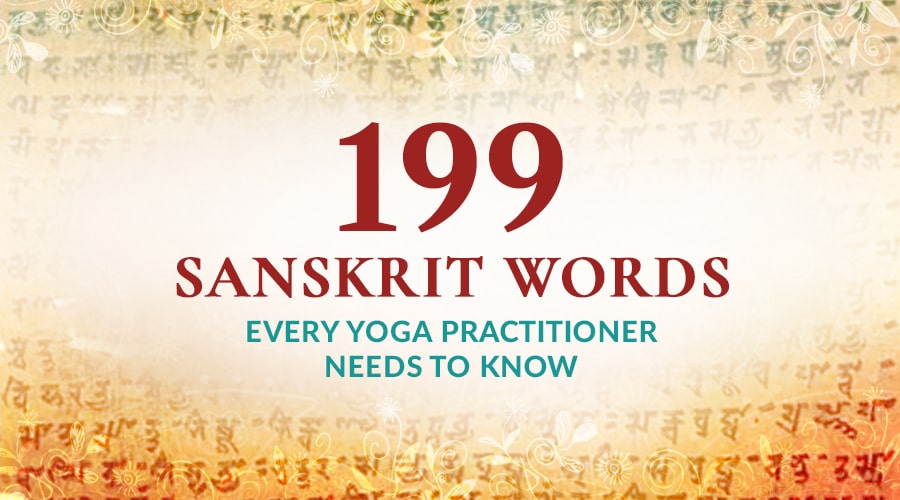When you step onto the yoga mat as a beginner, it's not just about learning poses or how to master the perfect “Om”. You'll also be introduced to hundreds of yoga terms from an ancient Indo-European language, known as Sanskrit. From "Ashtanga" and "Pranayama" to "Shavasana" and “Hatha,” Sanskrit words form the foundation of yoga as we know it today.
However, these words are more than just labels. Deep-rooted in centuries of tradition, they reveal the essence and meaning of popular yoga poses and practices. By embracing yoga terminology, we not only enhance our physical practice but also uncover new insights of yoga philosophy and the profound wisdom hidden in each word.
Regardless of whether you’re a complete newbie to yoga or a seasoned practitioner with a wealth of experience, this comprehensive yoga glossary breaks down the most important Sanskrit words you’ll need to deepen your practice and discover the true meaning of yoga.
What Is Sanskrit & Why Do We Use It in Yoga?
Sanskrit is an ancient Indo-European language that originated in the Indian subcontinent around 3500 years ago. Its rich and structured form has made it a subject of study not only in India but across the world.
While it is no longer spoken as a native language, Sanskrit continues to be taught, studied, and respected for its great contribution to literature and religious texts. Many of yoga's foundational texts, such as the "Yoga Sutras of Patanjali" "Bhagavad Gita" and various Upanishads, are all written in Sanskrit. These texts provide the philosophical and practical frameworks for much of what we understand as yoga today.
Sanskrit also plays a crucial role in the physical practice of yoga, with nearly all yoga asanas (poses) using Sanskrit names. For example, "Tadasana" means "Mountain Pose" and "Shavasana" is referred to as "Corpse Pose." Most concepts in yoga philosophy are also taken directly from traditional Sanskrit words.
What Is the Meaning of Yoga in Sanskrit?
In Sanskrit, the word "yoga" is derived from the root "yuj," which means "to yoke" or "to unite." Therefore, the Sanskrit meaning of yoga signifies union or connection. In the context of traditional yogic philosophy, "yoga" refers to the union of the individual self with the reality or the cosmic consciousness, which is the ultimate goal of the practice.
Beyond this, "yoga" can also refer to the methods or disciplines that help us achieve this union. It's a way of connecting the mind, body, and spirit. This is why many yoga practices often focus on aligning and harmonizing different aspects of the self, be it through physical postures, pranayama (breath control), meditation, or the Four Paths of Yoga.
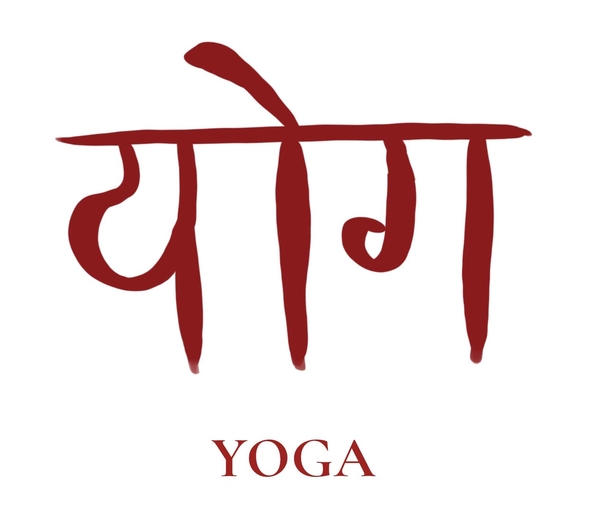
How to Pronounce Yoga Sanskrit Words?
In order to pronounce Sanskrit words accurately, you first need a basic understanding of the specific sounds in the Sanskrit alphabet. The good news is that Sanskrit pronunciation is quite phonetic, which means words are generally pronounced the way they are spelled. However, there are some nuances, and the Sanskrit alphabet contains several sounds that don’t exist in English.
Here are some basic guidelines to help you pronounce yoga Sanskrit words:
Vowels: Sanskrit words have short and long vowels. Lengthening the sound differentiates between the two. For example, "a" is a short vowel pronounced like the "a" in "but," while "ā" is a long vowel pronounced like the "a" in "father."
- Short vowel example in yoga: "a" as in "Adho" from "Adho Mukha Śvānāsana" (Downward-Facing Dog).
- Long vowel example in yoga: "ā" as in "Mālā" from "Japamālā" (a string of prayer beads).
Consonants: Some consonants in Sanskrit have unique pronunciations.
- "t" is pronounced with the tongue against the upper teeth, like in "Uttāna" from "Uttānāsana" (Standing Forward Bend).
- "ṭ" is pronounced with the tongue curled up against the roof of the mouth, like "Paṭṭabhi" from "K. Pattabhi Jois".
- "th" is a soft "t" followed by an "h", found in the yoga word "Hatha”, which we often mispronounce. This is not like the English "th" in "think" or "this", but rather a gentle “t” sound followed by a short puff of air.
Special Characters: Characters like "ṣ" and "ś" in Sanskrit words have unique pronunciations. These are both types of "sh" sounds, with "ṣ" being retroflex (pronounced with the tip of the tongue curled up toward the hard palate) and "ś" being palatal (pronounced with the body of the tongue raised against the hard palate). For example:
- "Ṣ" from "Ṣaṣāṅgāsana" (Rabbit Pose)
- "Ś" from "Śavāsana" (Corpse Pose)
Ultimately, the best way to pronounce Sanskrit words correctly is to listen to teachers well-versed in the language. Over time, you will get more comfortable with the unique sounds and gain the confidence to use these yoga terms in your daily practice.
199 Sanskrit Words to Deepen Your Practice
Below is a comprehensive list of Sanskrit words and terms for common poses, practices, and philosophies found in yoga. Most of these are yoga terms you would have come across in classes or courses, while others might be completely new to your lexicon. Take in these important words and their meanings and remember to use them in your daily practice for a deeper and more profound experience of yoga.
General Sanskrit & Yoga Terms
- Asana: The physical postures and poses practiced in yoga. Examples of common yoga asanas include Downward-Facing Dog, Warrior Pose, and Tree Pose.
- Ashram: Derived from the Sanskrit word "shrama," which means "labor", an ashram is a secluded residence where students or disciples live under the guidance of a teacher, guru, or spiritual leader.
- Chakra: Yoga term used to describe each of the 7 energy centers located along the spine in the subtle body, responsible for maintaining physical, emotional, mental, and spiritual balance.
- Dhanyavādaḥ: A Sanskrit term that means "thank you" or "gratitude." It's often used to express thanks or appreciation in a formal or respectful manner.
- Guru: In Hinduism, a guru is a respected spiritual teacher, guide, or mentor who provides knowledge and wisdom to their students or followers.
- Mantra: A sacred sound, word, or phrase repeated in meditation or chanting.
- Mudra: Sanskrit word for hand gestures used in meditation. See: Complete Guide to Mudras: Benefits and Use in Yoga, Meditation & Chakra Balancing
- Dhyan: Meaning meditation in Sanskrit, Dhyan refers to a state of the mind in which we experience a heightened level of awareness, concentration, inner peace, or self-realization.
- Namaskaram: Also called “namaskar”, or “namaste” in Hindi, it is a traditional Indian greeting or gesture of respect. The Sanskrit term namaskaram is derived from the word "namah" meaning "bow." When translated, it means "I bow to the divine in you" or "the divine in me sees the divine in you."
- Om: Pronounced “A-U-M”, Om is a sacred sound symbolizing the vibration of the universe; typically used in meditation and chanting.
- Prana: The vital life force or energy that sustains all living beings. The five major types of prana in yoga are Udana, Prana, Samana, Vyana, and Apana.
- Pranayama: Pranayama is the practice of breath control and regulation to enhance the flow of prana (life-force energy) in the body, aiding in mental clarity, self-awareness, and physical health.
Read: Pranayama Benefits & Daily Breathing Techniques for a Longer Life
- Satsang: A gathering of people to listen to or be in the presence of a guru, or to meditate and discuss spiritual matters.
- Sundara: A Sanskrit term that means "beautiful," "lovely," or "handsome."
- Shala: Meaning "home" or "school" in Sanskrit, shala refers to a place where yoga is taught and practiced.
- Shanti: Shanti is the yoga term for peace. In Hinduism, Buddhism, and other spiritual traditions, it is often chanted three times consecutively during prayers or meditations to invoke peace in body, speech, and mind.
- Svastha: Svastha is the Sanskrit word for health. It translates to "standing in one's own power" and is commonly used to mean "healthy" or "in good health."
Yoga
Yoga Practices
- Ashtanga Vinyasa Yoga: A rigorous style of yoga that follows a specific sequence of postures, synchronizing breath with movement.
See: Ashtanga Yoga, Ashtanga Vinyasa Yoga & Raja Yoga – Understanding the Differences
- Bhakti Yoga: The path of devotion and love towards a personal deity, emphasizing emotional union with the divine.
- Bikram Yoga: A style of hot yoga practiced in a heated room with a fixed series of poses, developed by Bikram Choudhury.
- Chakra Yoga: Chakra Yoga is the practice of classical Hatha Yoga poses in a downward-descending order to restore balance to the body’s energy centers, or chakras.
- Hatha Yoga: Meaning “stubborn” in Sanskrit, Hatha Yoga is the strict practice of asana, pranayama, dharana, and dhyana to achieve the sublime state of samadhi. Hatha is also thought to be a compound of the sun (ha) and the moon (tha), representing balance.
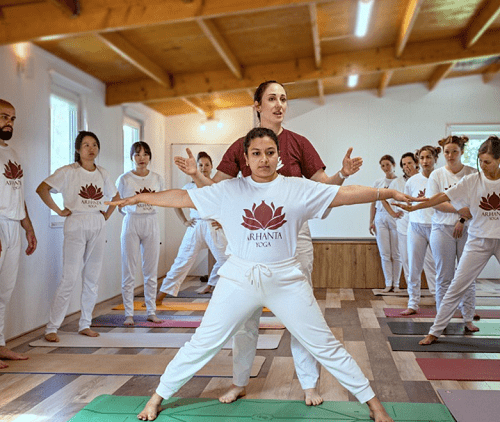
Experience authentic Hatha Yoga
Get free access to exclusive guided lessons with master teacher Kalyani Hauswirth-Jain
- Iyengar Yoga: A style of yoga which emphasizes alignment in postures using props like belts, blocks, and wall ropes.
- Jnana Yoga: Known as the Yoga of Knowledge, Jnana Yoga is the path of self-knowledge. Through dedicated study and introspection, it focuses on understanding the nature of reality.
- Karma Yoga: Meaning “action” in Sanskrit, Karma Yoga literally translates to the “Yoga of Action” or “Duty.” As the path of selfless action, it encourages action without any attachment to the results or outcomes.
Read: The Four Paths of Yoga Explained
- Kundalini Yoga: Yoga practice aimed at releasing kundalini energy in the body, typically involving rigorous exercises and breathwork.
- Prenatal Yoga: Designed for pregnant women, Prenatal Yoga teaches various practices that ease pregnancy pains and prepare for childbirth, which includes soothing yoga poses and breathing exercises.
- Restorative Yoga: Restorative Yoga is a gentle style of yoga with poses held longer, using props for deep relaxation.
- Raja Yoga: The path of self-control, Raja Yoga is centered on meditation and moral discipline, outlined in Patanjali's Yoga Sutras.
- Tantra Yoga: A spiritual practice that uses rituals, symbols, and yoga techniques to experience the divine and deepen connections.
- Vinyasa Yoga: Derived from Ashtanga Vinyasa Yoga, Vinyasa Yoga, or Vinyasa Flow, is a dynamic yoga style where sequences are fluid, moving from one pose to the next in a flowing manner.
- Yin Yoga: Yin Yoga is a slow-paced style of yoga with poses held for longer durations, focusing on connective tissues of the body.
Yoga Poses
- Adho Mukha Shvanasana (Downward-Facing Dog Pose): A foundational pose where the body forms an inverted "V" shape with palms and feet pressing down on the mat and hips lifted high.
- Adho Mukha Vrkshasana (Handstand Pose): A full inversion pose in which the practitioner balances on their hands while the feet are pointing upwards.
Read: How to Practice Yoga Inversions Safely
- Agnistambhasana (Fire Log Pose): A seated pose with legs stacked one over the other, resembling stacked logs in a fire.
- Akarna Dhanurasana (Archer’s Pose): Sanskrit term for a pose resembling an archer about to release an arrow from a bow. In this pose one foot is held by the hand while the other leg is extended straight.
- Anahatasana (Melting-Heart Pose): A prone pose in which the chest moves toward the ground, stretching the heart region.
- Ananda Balasana (Happy Baby Pose): Lying on the back, both knees are drawn into the chest and hands grasp the feet, mimicking a happy baby playing.
- Ardha Chandrasana (Half Moon Pose): A balancing pose in which one leg is extended horizontally and one hand on the ground, forming a T-like shape.
Note: Ardha means “half” in Sanskrit. So, if a yoga pose has “Ardha” before it, then it’s a variation where only half of the pose is practiced. This includes Ardha Matsyendrasana (Half Lord of the Fishes Pose) and the preparatory pose, Ardha Shirshasana (Half Headstand).
- Ashta Chandrasana (Crescent Moon Pose): A high lunge variation with the back heel off the ground and arms raised overhead, forming a crescent shape with the body.
- Ashtavakrasana (Eight-Angle Pose): An advanced arm balance pose where the legs are twisted around one arm, and the body is tilted to the side.
- Baddha Konasana (Bound Angle Pose or Cobbler's Pose): A seated hip opening yoga pose with soles of the feet together and knees splayed outwards.
Note: “Baddha” is the Sanskrit word for “bound”. Therefore, any yoga pose with “Baddha” at the beginning is a variation in which a part of the body is bound.
- Bakasana (Crane Pose): An advanced arm balance pose where the knees rest on the back of the upper arms and the feet lift off the ground.
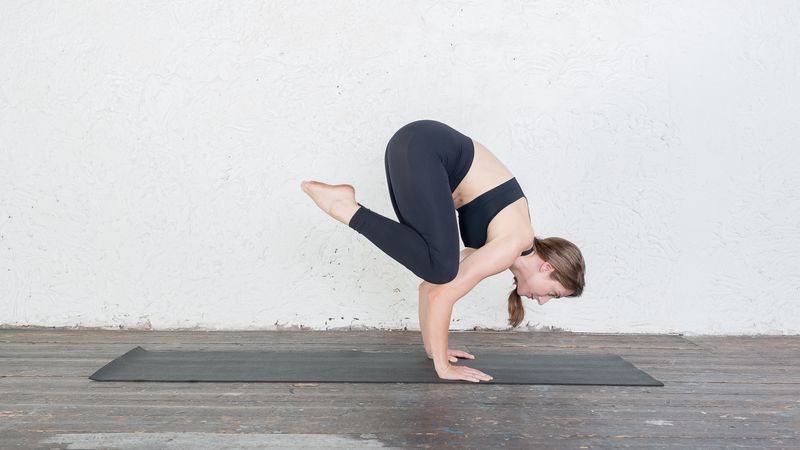
Kakasana (Classical Crow Pose)
- Bhujangasana (Cobra Pose): Sanskrit word for a deep backbend where the chest lifts off the floor, using the strength of the back muscles.
- Bhujapidasana (Shoulder-Pressing Pose): An arm balancing pose where the feet cross in front of the body and the hands are placed beside the hips.
- Chakrasana (Wheel Pose): A deep backbend where both hands and feet are on the ground and the body arches upwards, opening the chest.
- Dhanurasana (Bow Pose): Intensive yoga pose in which the practitioner lies on their stomach, grabbing the ankles and lifting the thighs and chest off the ground, forming the shape of a bow.
- Eka Pada Kapotasana (One-Legged Pigeon Pose) Popular hip-opening asana that stretches the hips, thighs, groin, and psoas.
Read: Hip Openers Unlocked: Guide to Strong & Tension-Free Hips
Note: “Eka Pada” means "one foot", so yoga poses with the Sanskrit word "Eka Pada" in the name refers to variations where most of the weight is on one leg.
- Ganda Bherundasana (Formidable Face Pose): An advanced posture that involves a deep backbend where the feet reach toward the head, while the practitioner's weight is supported on the hands and the chin.
- Garbhasana (Womb Pose): A seated yoga asana with the body threaded through the legs.
- Garudasana (Eagle Pose): A standing pose where arms and legs are intertwined, resembling an eagle.
- Gomukhasana (Cow Face Pose): A seated pose where knees are stacked on each other and arms reach behind to clasp, resembling the face of a cow.
- Halasana (Plough Pose): Intensive stretch lying on the back with legs lifted overhead until the toes touch the ground behind the head.

Halasana (Plough Pose)
- Hanumanasana (Monkey Pose or Split Pose): A full front split, named after the monkey god Hanuman.
- Janu Shirshasana (Head-to-Knee Pose): A seated forward bend where one leg is straight and the other is bent with the sole against the inner thigh.
- Jathara Parivartanasana (Belly Revolving Pose): A twisting pose, performed lying on the back, while maintaining shoulder contact with the ground.
- Kakasana (Crow Pose): An arm balance where the knees rest on the backs of the upper arms and the feet lift off the ground.
Read: Kakasana and Bakasana – A Guide to Practicing Crow and Crane Poses
- Krounchasana (Heron Pose): Seated with one leg extended straight and the other bent, foot beside the hip, the practitioner lifts the extended foot, holding it with both hands.
- Kukkutasana (Rooster Pose): From Padmasana (Lotus Pose), the practitioner inserts their arms through the spaces between their legs and torso and then lifts themselves off the ground.
- Kurmasana (Tortoise Pose): A forward bend where the practitioner sits with legs spread wide, then slides the arms under the knees while lowering the chest to the ground.
- Laghu Vajrasana (Little Thunderbolt Pose): From Ustrasana (Camel Pose), the practitioner bends backwards, bringing the crown of the head to the ground, while the hands grasp the ankles or calves.
- Lolasana (Pendant Pose): Sanskrit word for a challenging arm balance pose where the body is lifted off the ground and the legs remain crossed in a seated position, supported by the hands on the ground.
- Makarasana (Crocodile Pose): Lying face down, the hands are crossed under the head, and the head rests on the hands. This is a relaxation pose, often used to rest between other prone postures.

Makarasana (Crocodile Pose)
- Malasana (Garland Pose): A deep squat where the heels are on the ground (or supported) and the torso is nestled between the thighs.
- Mandukasana (Frog Pose): Frog Pose is a kneeling position typically practiced in Yin Yoga, where the practitioner widens their knees and comes onto the hands (or elbows) in front, resembling the stance of a frog.
- Marjaryasana I & II (Cat Pose): Often paired with "Bitilasana" for the Cat-Cow stretch. In Marjaryasana, from a hands and knees position, the spine is arched upward, tucking the chin to the chest.
- Matsyasana (Fish Pose): A reclining back-bending asana in Hatha Yoga where the practitioner arches the spine and rests on the crown of the head, opening the chest and throat.
- Mayurasana (Peacock Pose): An arm balance pose where the body is supported by the elbows and forearms, with legs extended straight back.
- Natarajasana (Lord of the Dance Pose): A balancing posture where the practitioner stands on one leg, lifting the other leg behind and grabbing the foot or ankle with one hand, while extending the opposite arm forward.
- Padmasana (Lotus Pose): Classic seated meditation posture with each foot placed on the opposite thigh.
See: Tutorial to a Pain-Free & Safe Lotus Pose
- Parighasana (Gate Pose): Sanskrit term for a side stretch in yoga where one knee is bent (like a gate) and the other leg is extended out.
- Paripurna Navasana (Full Boat Pose): Seated yoga pose in which the practitioner balances on the sit bones with legs and torso lifted, forming a "V" shape.

Navasana (Boat Pose)
- Parivrtta Parshvakonasana (Revolved Side Angle Pose): Twisting lunge with the opposite elbow hooked outside the bent knee.
Note: The Sanskrit word "Parivrtta" means “turn around” or “revolve”. Therefore, if a pose has "Parivrtta" in the name, it is a twisted variation. Other examples include Parivrtta Trikonasana (Revolved Triangle Pose), Parivrtta Paschimottanasana (Revolved Seated Forward Bend), and Parivrtta Uttanasana (Revolved Standing Forward Bend).
- Parshva Kakasana (Side Crow Pose): Arm balance with a twist, weight on hands, hips lifted.
Note: Meaning “side” in Sanskrit, "Parshva" refers to poses in which the torso is turned to one side, such as Parshva Shirshasana (Side Headstand), Parshva Trikonasana (Side Triangle Pose), and Parshva Vrkshasana (Side Tree Pose).
- Parshvottanasana (Intense Side Stretch Pose): Standing pose with a forward bend over one leg, hands clasped behind the back.
- Paschimottanasana (Seated Forward Bend): Sanskrit term for a seated pose with the torso folding over extended legs.
- Pashchima Namaskarasana (Reverse Prayer Pose): Hands are clasped in a prayer position behind the back.
- Pincha Mayurasana (Feathered Peacock Pose): A forearm stand, where the body is inverted and supported by the forearms.
- Prasarita Padottanasana (Wide-legged Forward Bend): Standing pose with a wide stance, bending forward.
- Purna Chakrasana (Full Wheel Pose): A deeper variation of the bridge pose, arching the back and lifting onto hands and feet.
Note: The Sanskrit term "Purna" means “complete.” In the context of yoga, it refers to the full, more advanced version of a pose, such as Purna Natarajasana (Full Lord of the Dance Pose) or Purna Ushtrasana (Full Camel Pose).
- Purvottanasana: Often referred to as the "Upward Plank Pose" or "Inclined Plane," Purvottanasana is a yoga asana that involves lifting the hips off the ground into a straight line from shoulders to heels.

Purvottanasana (Upward Plank Pose)
- Raj Bhujangasana (King Cobra Pose): An elevated variation of the Cobra Pose, with a deeper backbend.
- Sarvangasana (Shoulder Stand): An inverted yoga pose where the body is supported by the shoulders and the legs point upwards.
- Sashtang Pranam Asana: Also called Ashtanga Namaskara, this is a posture in which eight parts of the body (two hands, two feet, two knees, chest, and chin) touch the ground.
- Setu Bandhasana (Bridge Pose): Chest-opening yoga pose in which the practitioner lies on their back, lifting the pelvis while keeping the shoulders and feet on the ground.
- Shalabhasana (Locust Pose): Prone position, lifting the upper and lower parts of the body off the floor.
- Shashankasana (Child's Pose): Also known as Balasana, Shashankasana is a relaxed seated pose in which the practitioner leans forward with forehead on the ground and arms extended.
- Shavasana (Corpse Pose): Shavasana, or Savasana, is a resting pose typically practiced at the beginning and end of a yoga practice.
- Shirshasana (Headstand): Yoga inversion where the body is balanced on the head.
- Siddhasana (Accomplished Pose): Meaning “perfect pose” in Sanskrit, Siddhasana is a classical seated meditation pose practiced in Hatha Yoga.
- Sukhasana (Easy Pose): Meaning “happiness” “ease” or “bliss”, Sukhasana is an easy, cross-legged pose often practiced in meditation.
Note: Yoga pose names with "Sukha" often refer to easier, beginner-friendly variations. For example, Sukha Eka Pada Kapotasana (Easy One-Legged Pigeon Pose) and Sukha Gomukhasana (Easy Cow Face) are both milder versions suitable for beginner practitioners.
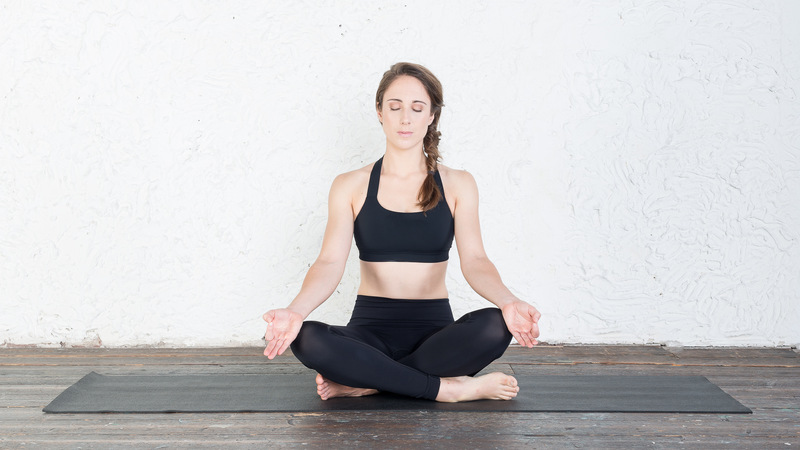
Sukhasana (Easy Pose)
- Supta Baddha Konasana (Reclining Bound Angle Pose): Lying on the back with soles of the feet together and knees falling out to the sides.
Note: The Sanskrit word "Supta" means "reclining" or "reclined," and is used to describe yoga poses that involve reclining while in the pose, such as Supta Eka Pada Kapotasana (Reclining One-Legged Pigeon Pose), Supta Padangusthasana (Reclining Hand-to-Big-Toe Pose), and Supta Virasana (Reclining Hero Pose).
- Surya Namaskara: Also known as Sun Salutation, Surya Namaskar is a sequence of postures performed in the early mornings at sunrise in a flow, traditionally to honor the sun. Today, it is also practiced to activate the energy in the body as preparation for more powerful asanas.
- Svarga Dvijasana (Bird of Paradise Pose): Standing pose holding one leg out to the side or extended upwards.
- Swastikasana (Auspicious Pose): This is a seated position with legs crossed in a specific interlocking manner, often practiced as an alternative to more advanced meditative poses like Padmasana and Siddhasana.
Check out: 8 Seated Yoga Poses for Flexibility
- Tadasana (Mountain Pose): Standing pose with feet together, arms by the sides, and spine erect.
- Tittibhasana (Firefly Pose): An arm balancing pose with legs extended outward, parallel to the ground.
- Tolasana (Scale Pose): Advanced asana in which the practitioner balances on their arms in a seated lotus pose, lifting the body off the ground using the hands.
- Trianga Mukhaikapada Paschimottanasana (Three-Limbed Forward Bend): Seated forward bend with one leg folded back and the other extended forward.
- Trikonasana (Triangle Pose): Sanskrit word for a standing pose with feet apart and palms together overhead reaching upward toward one side.

Trikonasana (Triangle Pose)
- Upavistha Konasana (Wide-Angle Seated Forward Bend): Seated pose with legs spread wide apart and the upper body leaning forward.
- Urdhva Baddha Hasta Tadasana (Upward Bound Hands Mountain Pose): Standing pose similar to Tadasana, but with arms extended upward and palms pressed together.
Note: The Sanskrit word "Urdhva" means “upward” or “up”, and is used to refer to yoga poses in which the torso is facing upward. Other examples include Urdhva Mukha Paschimottanasana I (Upward-Facing Intense West Stretch I) and Urdhva Mukha Shvanasana (Upward-Facing Dog Pose).
- Ushtrasana (Camel Pose): Kneeling backbend with hands on the heels or ankles.
- Utkatasana (Chair Pose): Standing pose with knees bent as if sitting in a chair, with arms extended overhead.
- Uttanasana (Standing Forward Bend): Standing pose, bending forward from the hips with hands touching the ground or the ankles.
- Vajrasana (Thunderbolt Pose): A kneeling pose with buttocks resting on the heels.
- Vashishtasana (Side Plank Pose): A balancing pose on one arm and the side of one foot, with the other arm and leg raised or extended.
- Vatayanasana (Horse Face Pose): A seated twist that involves bending one knee towards the chest and the other foot placed beside the opposite thigh.
- Viparita Dandasana (Inverted Staff Pose): An advanced backbend with the forearms and crown of the head on the floor and legs extended in a bench-like formation.
Note: The Sanskrit word "Viparita" means "inverted" or "opposite", and is used to describe yoga asanas that are inverted or upside down. Some examples include Viparita Karani Mudra (Upside-Down Seal), Viparita Navasana (Inverted Boat Pose), and Viparita Virabhadrasana II (Reverse Warrior Pose II).

Viparita Dandasana (Inverted Staff Pose)
- Virabhadrasana I (Warrior I Pose): A lunge with the back foot grounded at an angle, and both arms reaching upwards.
- Vrischikasana (Scorpion Pose): An inversion where the practitioner is in a forearm stand with a backbend, so feet come close to the head.
- Vrkshasana (Tree Pose): Standing pose where the practitioner balances on one leg with the other foot placed on the opposite inner thigh or calf, hands in prayer or extended overhead.
- Vyaghrasana I & II (Tiger Pose I & II): A kneeling pose where one leg is extended backward and the back is arched. The two versions might involve variations in leg and arm positioning.
Meditation
- Ajapa Japa Meditation: The continuous repetition of a mantra, often synchronized with the natural rhythm of inhalation and exhalation. It is a form of meditation where the mantra repetition becomes automatic and effortless, fostering a deep state of inner awareness and tranquility.
- Anapanasati: Mindful focus on breathing during meditation.
- Asato Ma Mantra Chanting: Chanting of the Sanskrit mantra "Asato Ma Sadgamaya", which means "lead me from untruth to truth".
- Chakra Dhyana: Yoga term for meditation that concentrates on unblocking and balancing the seven chakras through mantras, mudras and breathing techniques.
- Dharana: Concentrated focus, a stage before deeper meditation.
- Mala: String of prayer beads, traditionally made from 108 beads, used for counting to foster deeper concentration during mantra meditation.
- Mala Japa: Mala Japa is a meditation practice that involves the use of mala beads for mantra chanting.
- Trataka (Gazing Meditation): Sanskrit term for a meditation technique that involves focusing on a single point, like a candle.
- Yoga Nidra: Also known as "yogic sleep", Yoga Nidra is a type of meditation where deep relaxation is achieved while maintaining consciousness.
Read more: Yoga Nidra vs Meditation - What’s the Difference?
Pranayama
- Anulom Vilom: Also known as Alternate Nostril Breathing, Anuloma Viloma is a cleansing breathing exercise designed to balance the body's energy channels.
- Bandha: Meaning “lock” in Sanskrit, Bandha is an energetic seal used to harness and redirect the flow of prana (life-force energy) during yoga practices. The three primary bandhas are Mula Bandha (root lock), Uddiyana Bandha (abdominal lock), and Jalandhara Bandha (throat lock).
Read: The Bandhas: Complete Guide to the 4 Energy Locks
- Bhastrika: Known as Bellows Breath, Bhastrika Pranayama involves rapid and forceful inhales and exhales.
- Brahmari: Also called Bumblebee Breath or Humming Bee Breath, Bhramari Pranayama is a calming breathing technique that has a soothing and healing effect on the mind.
- Kapalabhati: In Sanskrit, "kapal" means “skull” and "bhati" means “shining.” Often referred to as Skull Shining Breath or Breath of Fire, Kapalabhati is a pranayama breathing technique that focuses on short, forceful exhales followed by passive inhales. It is also practiced as a yoga cleansing technique to clear the sinus.
- Nadi Shodhana: Another form of alternate nostril breathing aimed at purifying the energy channels (nadis) of the body.
- Sitali: Known as Cooling Breath, Sitali Pranayama involves curling the tongue into a tube-like shape and inhaling through it to cool down the body.
- Ujjayi: Known as Victorious Breath or Ocean Breath, Ujjayi is a yoga breathing technique characterized by a slight constriction of the throat, creating a soft, ocean-like sound on both the inhale and exhale.
Discover: Differences Between Ujjayi Breath & Ujjayi Pranayama
Yoga & Vedic Philosophy
- Agni: Yoga term for the digestive fire or the transformative energy that digests and metabolizes food, thoughts, and experiences.
- Ahimsa: The principle of non-violence toward all living things.
- Ajna Chakra: Referred to as the Third Eye Chakra, Ajna is the sixth of the primary energy centers. Located between the eyebrows, it relates to intuition, insight, and inner wisdom.
- Anahata Chakra: The fourth energy in the body, also called Heart Chakra. It is located in the center of the chest and governs love, compassion, and emotional balance.
- Aparigraha: The principle of non-greed or not taking more than one needs.
- Asamsakti (Non-Attachment): Sanskrit word for a deeper state of non-attachment to the material world, described in the Yoga Vashistha’s Seven Stages of Knowledge.
- Ashtanga Yoga: Patanjali's Eight Limbs of Yoga, an eight-fold path to ultimate awareness, consisting of Yama (moral ethics), Niyama (self-discipline), Asana (physical postures), Pranayama (breath control), Pratyahara (sensory withdrawal), Dharana (focused concentration), Dhyana (meditation), and Samadhi (spiritual enlightenment).
- Asteya: The principle of non-stealing or taking only what is freely given.
- Astraeya: Refers to divine conduct, adhering to the highest ethical and moral standards.
- Atman: The inner self or soul, considered eternal and divine.
- Atma-nivedanasakti: Part of Bhakti Yoga, it is the act or power of dedicating oneself to a divine entity, relinquishing personal ego and desires.
- Avidya: Spiritual ignorance or misunderstanding, seen as the root of all suffering.
- Ayurveda: An ancient Indian holistic healing system based on balancing the body's three primary energies or doshas, emphasizing diet, herbal treatments, and yogic practices.
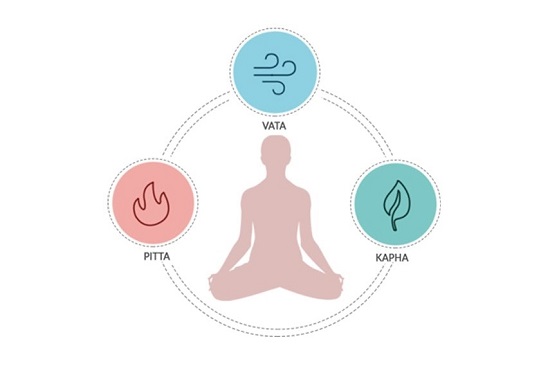
Online Ayurveda Course
Understand the Science of Ayurveda. Join our 12-hour Online Course and Become a Certified Ayurveda Practitioner
- Brahman: Sanskrit word that refers to the ultimate reality or supreme cosmic power. It is the unchanging, infinite, and transcendent reality, which serves as the source of all things.
- Brahmacharya: The principle of non-indulgence or responsible and balanced use of one's energy.
- Chitta: The mind or consciousness, especially in its ever-changing aspect.
- Chitta bhumisi: The various thought-waves or modifications of the mind. In yoga philosophy, Patanjali identifies 5 key states of mind, or “vrtti'' that we need to transcend to reach the ultimate state, samadhi.
- Dasyasakti: In Bhakti Yoga, it is the act of selflessly serving a divine entity, often with the attitude of a devoted servant or disciple.
- Dharma: Duty, righteousness, or one's purpose in life.
Also read: Karma and Dharma: Are You Doing It Right?
- Dhatu Agnis: In Ayurveda, each of the seven dhatus (body tissues) has its own specific agni. These are: Rasa (fluids or plasma), Rakta (blood), Mamsa (muscles), Meda (fat), Asthi (bones), Majja (bone marrow), Shukra/Artava (reproductive tissue).
- Dosha: Meaning “fault” or “accumulation”, the Sanskrit word dosha refers to one of the three primary life forces or energies in Ayurveda (Vata, Pitta, and Kapha) that govern physiological activity in the body.
- Drishti: A focused gaze used in meditation and certain yoga practices.
- Ekagra: Also called crane mind, Ekagra is the one-pointed or concentrated state of mind, indicating focus and clarity in yogic thought.
- Guna: Sanskrit word for the three qualities of nature: Sattva (purity), Rajas (activity), and Tamas (inertia). These qualities affect our thoughts, actions, habits and traits that make us who we are.
- Jatharagni: The main digestive fire, or agni, responsible for digesting the food we eat. It transforms the food into nutrients that the body then absorbs, helping us regulate vital bodily processes and maintain good health.
Read more: What Is Jatharagni? In-depth Guide to Digestive Fire & How to Boost Gut Health
- Jiva: The individual soul or living being, as distinct from the universal Atman.
- Karma: The law of cause and effect, determining the nature of one's reincarnations.
- Klesha: The Sanskrit word Klesha means “obstacles” or “afflictions” that cloud our better judgement and hinder spiritual progress.
- Kosha: The five sheaths or layers of the self: Annamaya Kosha (food sheath), Pranamaya Kosha (sheath of prana or life), Manomaya Kosha (mind sheath), Vijnanamaya Kosha (knowledge or wisdom sheath), and Anandamaya Kosha (bliss sheath).
- Kshipta: The first yogic state of consciousness. Often described as monkey mind, it is a state of restlessness where the mind constantly shifts from one thought or emotion to another.
- Maha Bandha: Often referred to as “great lock”, Maha Bandha is an energy seal where all three primary bandhas are engaged simultaneously.
- Manipura Chakra: Also known as the Solar Plexus Chakra, it is the third energy center located above the navel and is associated with personal power, self-worth, and confidence.
- Maya: Meaning of “Maya” in Sanskrit is "illusion" or "deception." In Hindu and Yoga philosophy, Maya is the powerful force that creates the cosmic illusion, making the world appear real and obscuring the true nature of reality, or Brahman.
- Moksha: The plane where the soul goes after the liberation or freedom from the cycle of birth and death.
- Mudha: A second state of mind, often characterized by ignorance or lack of awareness in yogic psychology.
- Muladhara Chakra: The Root Chakra is the first energy center in the body, situated at the base of the spine. It's linked to security, stability, and foundational needs.
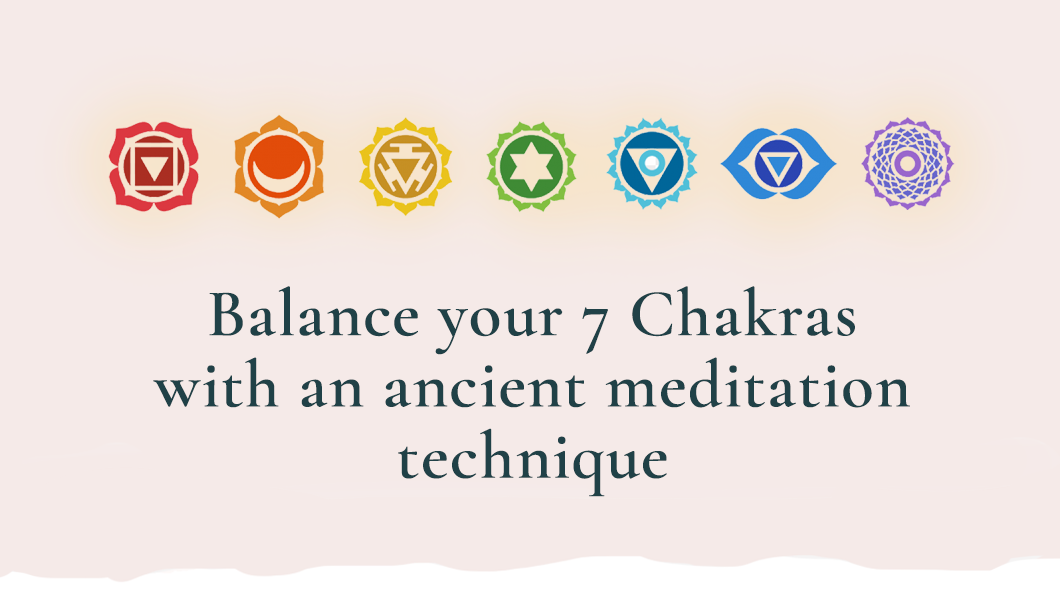
Get free access to the guided meditation with master teacher Ram Jain
- Mumukshutava: An intense desire for spiritual liberation or moksha.
- Nadis: The energy channels through which prana (life-force energy) flows within the subtle body, supporting physical and spiritual well-being.
- Neti Neti: Sanskrit word for the process of self-inquiry, meaning "not this, not this."
- Niruddha. This is the mastered mind or a yogi mind. In this state, your mind is completely still and no longer agitated or disturbed by external or internal factors.
- Nivritti Dharma: This is the path of detachment and ultimate self-realization. It emphasizes turning away from the world to seek spiritual enlightenment and liberation (moksha).
- Niyama: The second limb of yoga, outlining personal observances or disciplines. Examples include Saucha (cleanliness), Tapas (austerity), and Svadhyaya (self-study).
- Padarthabhavana (Perception of Truth): A stage of knowledge in yoga philosophy in which one sees the truth beyond the illusion.
- Prakriti: The material nature or primal matter from which everything in the physical universe arises.
- Pravritti Dharma: Refers to the path of righteous engagement in the world, including fulfilling one's duties (dharma) and responsibilities in society, family, and work.
- Pujashakti: Part of Bhakti Yoga, it is the act or power of honoring and worshipping a Divine entity or through rituals and ceremonies.
- Sadhana: The dedicated and disciplined practice of activities like asana, pranayama, and meditation to achieve spiritual growth or realization.
- Sadhaka: A spiritual seeker dedicated to achieving self-realization or spiritual growth.
- Sadhu: A wise and knowledgeable person, often considered spiritually enlightened, who is widely respected for their profound insight and understanding.
- Sahasrara Chakra: The seventh chakra in the energy body. Known as the Crown Chakra, it is positioned at the top of the head and is related to spiritual connection, enlightenment, and consciousness.
- Samskara: In Indian and yoga philosophy, Samskara are the imprints or impressions left on the subconscious mind by past experiences, which can influence future behavior and patterns.
- Sattvapatti (Attainment of Purity): The fourth stage of knowledge in yoga philosophy. Here, the mind reaches a state of purity and clarity.
- Satya: The principle of truthfulness in thoughts, words, and actions.
- Shakti: Shakti represents the feminine principle of divine energy and is often associated with the mother goddess in Hinduism and yoga philosophy.

Discover yoga philosophy principles to boost your happiness
Get free access to a life-changing series of 6 webinars with Arhanta Yoga founder Ram Jain
- Shat Kriya (or Shatkarma): A set of six cleansing techniques in Hatha Yoga aimed at purifying the body and balancing energies. These practices also prepare the body for the advanced techniques of pranayama and meditation.
- Shatsampat: Mastery of the six senses — hear, touch, see, taste, smell and intuition — in the Seven Stages of Knowledge.
- Subheccha (Desire for Truth): The first of the Seven Stages of Knowledge in the Yoga Vashistha. Subheccha is the initial awakening where one has a sincere desire for spiritual truth and understanding.
- Sutra: A short, aphoristic statement or collection in Sanskrit literature. This is commonly used in yoga to refer to Patanjali's Yoga Sutras.
- Svadharma: One's own individual duty or path in life.
- Svadhisthana Chakra: The Sacral Chakra is the second energy center in the body, situated just below the navel. It is often associated with creativity, sexuality, and emotions.
- Swami: Sanskrit word for a master.
- Tanumanasa (Attenuation of Mind): The third stage of knowledge where the mind begins to focus, leading to less distraction from worldly attachments.
- Turiya: This is the stage of perpetual Samadhi, often described as a spiritual awakening or self-realization. It is the final stage of knowledge where karma is complete and the seeker is almost ready to be liberated.
- Vairagya: A state of dispassion or detachment from material desires, focusing instead on spiritual goals.
- Vicharana (Self-Inquiry): The second of the Seven Stages of Knowledge. It is the stage of reflection and introspection, seeking to understand the nature of the self.
- Vikshipta: A distracted or agitated state of mind, characterized by intermittent focus in yogic psychology.
- Vishuddha Chakra: Often referred to as the Throat Chakra, Vishuddha is the fifth energy center. Found in the throat, it’s associated with communication, self-expression, and truth.
- Viveka: The power of discernment; the ability to distinguish between the real (unchanging, eternal) and the unreal (changing, transient).
- Yamas: Ethical standards or moral disciplines, the first limb of Patanjali's eight-limbed path. Yamas include Ahimsa (non-violence), Satya (truthfulness), and Asteya (non-stealing).
Discover: How to Practice the Yamas
Final Thought
Learning Sanskrit words and yoga terms goes beyond memorizing poses and chakra names; it's a bridge to yoga's rich history and deeper meanings. By taking the time to understand yoga's terminology, we are able to gain profound insights into the true essence of yoga and the wisdom preserved in these words and phrases.

